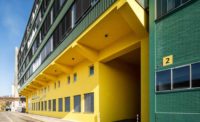Why do some exterior coatings seem to perform for decades while others blister, peel, crack and degrade within just a few years? While the topcoat formulation is certainly a factor for providing long-term performance, the majority of these field-applied coating failures can be traced to poor surface preparation and priming.
Building owners, architects and project specifiers embarking on exterior restoration projects need to carefully consider every step in the surface preparation process and be vigilant in their efforts to specify the proper primer for the job. Taking careful steps at the start of the coating project will help ensure proper adhesion of the topcoat, appropriate protection for the substrate and long-lasting performance of the entire coating system.
Surface, Substrate and Environmental Conditions
Not all surfaces are equal. A primer that works well for stucco, masonry and concrete may not work well on metal, polyester, vinyl or factory-coated surfaces, for example. In addition to unique surface tension and adhesion properties, different substrates age differently. Concrete and cement are high alkalinity surfaces prone to salt migration, chalking, and moisture issues due to ultra-violet (UV) degradation, abrasion and other stresses. Therefore, cleaning properly, eliminating moisture and testing pH level are critical considerations. Metals can oxidize and corrode over time, so corrosion mitigation is a necessary first step.
The primer is the undercoating or base coat that is applied before the final top coating. Primers fill the pores of the surfaces to be coated and increase the adhesion of the coating. A primer coat helps to seal the surface, hide stains, prevent bleed-through, and create a neutral base for any coating color. If the primer formulation is not engineered for the surface or environmental circumstances, pre-existing issues are likely to progress after refinishing. It also can be complicated to consider that the same building material may require different primers based on pre-existing conditions, such as the degree of aging of the building material and the type and condition of existing coatings, or the environmental factors the coating will be exposed to after the installation, such as salt and water migration or abrasion.
During the installation, ambient environmental conditions can affect the performance and cure time of the primer. Pay attention to the primer manufacturer’s guidance on air temperature and humidity levels, as well as the proper range in surface temperature. Typically, contractors should avoid applying the primer if precipitation is expected within 24 hours and/or if the air or surface temperature is expected to drop below 35oF within two days.
These considerations should be worked into the project timeline. Additional environmental conditions of concern include:
- Sunlight: Although sometimes difficult to avoid, extended exposure to direct sunlight may affect the flow, leveling, dry rate and application characteristics of the primer.
- Wind velocity: High wind velocity can severely impact spray application, which can result in loss of materials, low film build, excessive dry spray or overspray. It can also impact other methods of application by expediting the dry rate too much. Wind conditions below 15 mph are typically recommended, which can be a challenge for coastal properties. However, if unavoidable, defer to the manufacturer's recommendations to extend the dry rate as much as possible.
- Dust and contamination: Work areas should be protected from conditions where dust and contamination are probable during the application and curing process. Dust and contaminants that settle on freshly applied primer can impair the adhesion integrity of the primer, leading to shorter coating life and reduced performance.
Surface Preparation, Primer Application and Inspection
Inadequate surface preparation and improper primer application can lead to coating system failure. Some substrates require additional preparation. The condition of the existing coating system will indicate whether complete or partial removal, such as light sanding, prior to recoating is the best solution for surface preparation.
Before applying the primer, all areas should be examined for pre-existing coating defects such as holidays, crazing, cracking, blisters, efflorescence, blushing, chalking, etc., as well as surface or substrate defects such as improperly welded areas, cracks, mold growth and corrosion. Proper mitigation should be taken to resolve all issues using SSPC, NACE or ISO standards. Surfaces should be completely cleaned by blast, power tool, or hand tool method as well as solvent wipe cleaning to remove all contaminants including chlorides, sulfates and nitrates, oil, grease, soil, dust, and mill scale. The risk of coating failure can be greatly reduced by increasing coating adhesion, decreasing contamination, and improving attention to detail. Additional surface preparation guidance should be available in the primer manufacturer’s Field Coatings Guide, technical data sheet and specification document.
Understand installation parameters by asking the manufacturer or a manufacturer-approved applicator how the primer is ideally applied, whether by conventional spray equipment, HVLP, airless, or brush and roll. Applying the primer uniformly and properly is critical, as a corrosion reaction can happen in an area smaller than a pinpoint. To ensure proper primer thickness, applicators should use a wet film gauge and record readings from multiple locations immediately after application. The target wet and dry film thicknesses are based on the solids content of the primer and can be found on the manufacturer’s technical data sheet.
Excessive primer on the surface may result in runs, sags and weak spots, as well as delay dry time and potentially create inter-coat adhesion problems. On the other hand, skips and holidays can result when film thickness is too thin, which could lead to corrosion or adhesion issues from exposing the substrate to the topcoat or even the elements. With uneven film thickness, striping and banding as well as mottling can appear, impairing the overall aesthetic, even after the top finish is applied. Dry film thickness readings are also advised using a relevant DFT gauge per SSPC-PA 2. Record DFT in five locations on the surface, three times in each location, then compute the adjusted average to learn if the coated area is in spec.
It is highly advised to specify preparation and coating of a mock up with the primer before the full installation, and to test that mock up with ASTM D3359 Standard Test Method for Measuring Adhesion by Tape Test. Results of this test will indicate how well the primer has adhered to the substrate on a scale of 1 to 5, with 5 being the best. A score below 4 likely indicates either that a different primer should be used or that the surface was not prepared adequately prior to primer application.
Guidance on proper surface preparation can be obtained from an expert in coating application or the manufacturer referencing SSPC, NACE or ISO standards for surface preparation and testing of the substrate prior to coating. If poor surface preparation is eliminated as the cause of a low adhesion score, defer to the manufacturer for direction on new primer candidates for the specific project and topcoat. Multiple primer options could be included in the specification for verification during the mock up.
Total System Approach
Think of coatings as more than just paint; they are a complete exterior restoration system and could be looked at as a new building envelope. Compatibility between the primer and topcoat and understanding the engineering behind the formulations are critical. It’s important to specify a primer and topcoat system from one manufacturer as they will be specifically formulated and tested for compatibility and will include warranties on performance as a complete system.
Many in the architectural restoration industry have turned to water-based coating systems with high-performance Polyvinylidene Fluoride (PVDF) binders, a tough engineering thermoplastic with a proven record of weathering performance for over 50 years. The strong carbon-fluorine bonds that make up PVDF resist harsh thermal, chemical and UV conditions. This minimizes coating degradation and erosion, while protecting the primer and surface below for the long-haul. PVDF coatings can provide the lifecycle and durability of a factory-applied coating in a field application, however, primer compatibility is essential for these coating types.
Being water-based, with high surface tension and the hydrophobic properties of highly concentrated fluorine, PVDF coatings often pose adhesion challenges. Experts in coating development, polymer composition, and chemical rheology of PVDF-based systems understand the chemistry behind these challenges and have designed primer systems that correspond to the topcoat on a molecular level.
An experienced manufacturer-approved applicator’s expertise as well as the manufacturer's guidance in specifying the right coating system for the structure’s substrate, preparing the surface properly, perfecting the application and employing proper inspection measures will help ensure total and long-term success of the exterior restoration project.


.jpg?height=200&t=1645633720&width=200)

